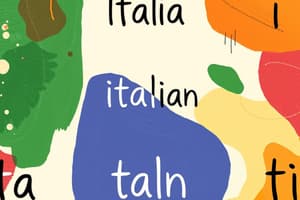Podcast
Questions and Answers
Which of the following transformations correctly demonstrates the standard pluralization rule for masculine Italian nouns ending in '-o'?
Which of the following transformations correctly demonstrates the standard pluralization rule for masculine Italian nouns ending in '-o'?
- Tavolo (table) → Tavola
- Museo (museum) → Musei
- Fiore (flower) → Fiori
- Amico (friend) → Amici (correct)
What is the correct plural form of the Italian word 'telecamera' (camera)?
What is the correct plural form of the Italian word 'telecamera' (camera)?
- Telecamerae
- Telecami
- Telecamero
- Telecamere (correct)
Given the rule that nouns ending in '-e' change to '-i' in the plural form, which of these pluralizations is correct?
Given the rule that nouns ending in '-e' change to '-i' in the plural form, which of these pluralizations is correct?
- Stazione (station) → Stazioni
- Nave (ship) → Navi (correct)
- Pesce (fish) → Pesca
- Chiave (key) → Chiavi
Which of the following Italian words does NOT follow the standard rules for pluralization?
Which of the following Italian words does NOT follow the standard rules for pluralization?
If you wanted to indicate that there are multiple 'arms' in Italian, what word would you use?
If you wanted to indicate that there are multiple 'arms' in Italian, what word would you use?
Considering the rules for forming plurals in Italian, which of the following sentences is grammatically correct?
Considering the rules for forming plurals in Italian, which of the following sentences is grammatically correct?
What would be the plural form of the word 'lago' (lake)?
What would be the plural form of the word 'lago' (lake)?
How would you write 'the mothers' in Italian?
How would you write 'the mothers' in Italian?
Flashcards
Masculine Nouns (-o to -i)
Masculine Nouns (-o to -i)
Change the -o ending to -i to make most masculine nouns plural.
Feminine Nouns (-a to -e)
Feminine Nouns (-a to -e)
Change the -a ending to -e to make most feminine nouns plural.
Nouns Ending in -e (-e to -i)
Nouns Ending in -e (-e to -i)
Change the -e ending to -i to make nouns plural, regardless of gender.
Uomo → Uomini
Uomo → Uomini
Signup and view all the flashcards
Mamma → Mamme
Mamma → Mamme
Signup and view all the flashcards
Braccio → Braccia
Braccio → Braccia
Signup and view all the flashcards
Bambino → Bambini
Bambino → Bambini
Signup and view all the flashcards
Macchina → Macchine
Macchina → Macchine
Signup and view all the flashcards
Study Notes
- Italian Made Easy simplifies Italian learning, beginning with turning singular nouns into plurals.
Basics of Pluralizing Nouns
- Most masculine nouns ending in -o change to -i in the plural form.
- "Libro" (book) becomes "libri" (books).
- "Gatto" (cat) becomes "gatti" (cats).
- Feminine nouns typically end in -a, which changes to -e for the plural.
- "Casa" (house) transforms into "case" (houses).
- "Ragazza" (girl) becomes "ragazze" (girls).
- Nouns ending in -e change to -i in the plural, irrespective of gender.
- "Studente" (student) becomes "studenti" (students).
- "Lezione" (lesson) becomes "lezioni" (lessons).
Irregular Plurals
- Not all nouns follow standard pluralization rules.
- "Uomo" (man) becomes "uomini" (men).
- "Mamma" (mom) becomes "mamme" (moms).
- "Braccio" (arm) becomes "braccia" (arms).
Practice Round Examples
-
"Bambino" (child) becomes "bambini."
-
"Macchina" (car) becomes "macchine."
-
"Pesce" (fish) becomes "pesci."
-
Recognizing Italian plural patterns becomes intuitive with practice.
Studying That Suits You
Use AI to generate personalized quizzes and flashcards to suit your learning preferences.




